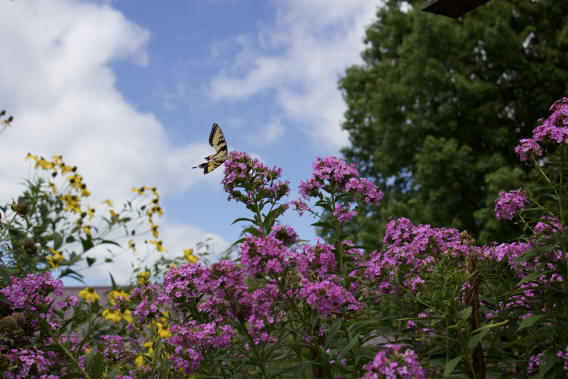Tall Garden Phlox (Phlox paniculata) is a must have HAVE for any good pollinator garden. It is my favorite pollinator plant. This is a large, lovely garden plant that is beloved by butterflies, bees and other pollinators. It is a long-lived, long-blooming, native perennial. If you want to attract butterflies, this is your plant. Tall phlox likes full sun, good drainage, and space to breathe. There is also a Woodland Phlox that likes shade.

Limit the Fertilizer
Being native, Garden Phlox really doesn’t need much fertilizer. Many times, too much fertilizer on a plant that doesn’t need it will actually encourage disease and cause plants to flop. Mine get a healthy dose of compost as a mulch around their root area in the early spring. Compost is great for the soil. It improves drainage but also helps the soil retain moisture. It will keep the soil very workable, never becoming rock hard from the effects of the summer sun.
Nativars
You can find Tall Phlox in many different color shades from white to pink to bright purple. I have even seen it in orange. These are nativars. (A native plant that has been altered to produce some desired characteristic.) The pure species is lilac in color. The phlox we find in the nurseries are usually nativars. They have been bred to give a spectacular appearance in the garden, and they certainly do.
Native plant enthusiasts tell us that native pollinators prefer the straight species over the nativars. Not too many nurseries, with the exception of native plant nurseries, carry the straight species. There is a difference in the quality of the nectar, and the insects definitely know the difference. The late Sinclair Adam, Horticulture Extension Educator and Flower Trials Director with Penn State University Extension in Lebanon, PA told us that some nativars deliver equal or even better nectar for pollinators, but he warned that certain characteristics to avoid in nativars are change in leaf color of the plant and "double" flowers.
In my garden, I have a large patch of the straight species, and I also have several nativars in bright pink, purple and white. They are all beautiful, but when I go outside with my camera looking to photograph butterflies or hummingbirds, I go to the straight species. That’s where all the action can be found. It is actually difficult to get a picture of this great perennial without getting some sort of wildlife in the picture.
Based on a lengthy trial, Mr. Adam highly recommended the nativar ‘Jeanna’ which, he said, has a very high-quality nectar and attracts even more pollinators than the straight species. I bought one of these plants last fall and can hardly wait to see how it performs this summer. Some other phlox varieties that are recommended for our area are ‘David’, ‘Bright Eyes’, ‘Eva Cullum’ and ‘Russian Violet’ to name a few. These have been bred for disease resistance and amazing color.
Avoid Disease
Unfortunately, Tall Phlox is known for susceptibility to powdery mildew. I actually have quite a few of the above-mentioned varieties all claiming to be mildew resistant. They all get it when conditions for mildew exist.
If you have had trouble with disease on your Garden Phlox, here are a few tips. First, place the plant in full sun uncrowded by other plants. Lots of air movement will discourage the disease. Try removing a few of the inside stems which will open up the plant and improve the air circulation. Another benefit of thinning out some stems is that they will grow back and flower later than the rest of the plant, thus prolonging the bloom. Also, watch the plant closely in the spring for signs of diseased leaves which often start at the bottom. Remove any leaves that don’t look healthy and dispose of them in the trash. Disease spores can grow and multiply in the soil as well as being airborne. Finally, when watering, try hard to avoid wetting the leaves. Dampness promotes disease.
If your plant does get disfigured by disease early in the season, just cut the entire thing off at ground level. It will grow back with healthy leaves, and hopefully, it will bloom late in the season when everything else is done. It’s very cool to have bright flowers blooming in late October.
Divide to Get More
If you have a Garden Phlox that you really like, it is very easy to divide it to get more. Early in the season, at the first sign of new green leaves, dig up the clump. Divide it into two or more sections and replant. It’s very easy. Usually, when dividing the phlox, it is easy to pull the sections apart with your hands, gently separating the roots. If it turns out that they don’t come apart easily, it will not hurt the plant to break the sections apart with a sharp spade. Just replant the sections quickly and thoroughly water them in.
Read other articles on ecological gardening & native plants
Read other articles on birds, wildlife & beneficial insects